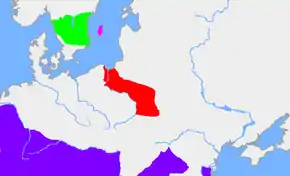Berig
Berig is a legendary king of the Goths appearing in the Getica by Jordanes. According to Jordanes, Berig led his people on three ships from Scandza (Scandinavia) to Gothiscandza (the Vistula Basin).[1] They settled and then attacked the Rugians who lived on the shore and drove them away from their homes, subsequently winning a battle against the Vandals.[2]

Arne Søby, a Danish historian, has nonetheless proposed that Cassiodorus, who wrote the original text on which Jordanes's work is based, invented Berig, with inspiration from the name of Βέρικος (Berikos or Verica).[3] Some archaeological research indicates, however, that the transition of the Oksywie culture into the Wielbark culture was peaceful and its timing coincides with the appearance of a new population of Scandinavian origins in the previously uninhabited area ("no man's land") between the Oksywie and Przeworsk culture areas.[4]
The 16th-century Swedish archbishop of Uppsala Johannes Magnus, in his history of the Swedes and Goths, was the first to publish a song known as the "Ballad of Eric", about an early Gothic king called Eric, who bears some similarities to Berig. It was once thought to contain authentic folk tradition about the king, but it is now regarded as inaccurate.[5][6] However, Magnus discusses King Berig separately as having united the Swedes and Goths some 400 years after Eric's death.
In popular culture
In popular culture, Berig is referenced (as Berik) in the song "Three Ships of Berik, Pts. 1 and 2" by Swedish symphonic metal band Therion.
Notes
- Jordanes, Charles Christopher Mierow (ed.), Getica 25
- Jordanes, Mierow (ed.), Getica 313
- Arne Søby Christensen (2002), Cassiodorus, Jordanes, and the History of the Goths. Studies in a Migration Myth, p. 303, ISBN 978-87-7289-710-3, archived from the original on 2007-08-21, retrieved 2007-08-18
- Kokowski 1999
- K.R. Geete (1907), "Eriksvisan", Nordisk familjebok
- Bengt R. Jonsson (1967), "Balladpastischer", Svensk balladtradition, pp. 676–681
References
- (in German) Andrzej Kokowski "Archäologie der Goten" 1999 (ISBN 83-907341-8-4)